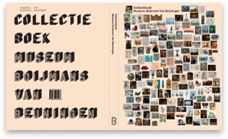Unica Zürn became known as a writer and artist in the 1950s in Germany. Zürn had a tough childhood and after experimenting with mind-expanding drugs, she developed a severe mental illness from around 1960. A majority of artworks were produced during the years she spent in mental institutions. ‘Composition’ is a part of a larger body of work that reflects on the sense of being observed by both staff and fellow patients in the institution. Zürn died in 1970 after jumping from a window of her life partner Hans Bellmer’s apartment, leaving a small artistic oeuvre.

Specifications
| Title | Komposition |
|---|---|
| Material and technique | Gouache on blue paper |
| Object type |
Drawing
> Two-dimensional object
> Art object
|
| Location | This object is in storage |
| Dimensions |
Height 238 mm Width 165 mm |
|---|---|
| Artists |
Artist:
Unica Zürn
: Claude de Muzac |
| Accession number | MB 2011/T 6 (PK) |
| Credits | Purchased with the support of VriendenLoterij, 2011 |
| Department | Drawings & Prints |
| Acquisition date | 2011 |
| Creation date | in 1955 |
| Provenance | Estate Unica Zürn; Galerie Berinson, Berlin 2011 |
| Exhibitions | Rotterdam 2017b |
| Internal exhibitions |
The Collection Enriched (2011) Surrealism and Beyond (2016) Collectie - surrealisme (2017) |
| External exhibitions |
Surrealist Art - Masterpieces from Museum Boijmans Van Beuningen (2021) A Surreal Shock. Masterpieces from Museum Boijmans Van Beuningen (2023) Dalí, Magritte, Man Ray and Surrealism. Highlights from Museum Boijmans Van Beuningen (2023) A Surreal Shock – Masterpieces from Museum Boijmans Van Beuningen (2021) Only the Marvelous is Beautiful (2022) |
| Research |
Show research A dream collection - Surrealism in Museum Boijmans Van Beuningen |
| Literature | Brinkmann/Helmes/Knapp 1998, pp. xxiii, 213 |
| Material | |
| Object | |
| Technique |
Gouache
> Drawing technique
> Technique
> Material and technique
|
Entry catalogue A dream collection - Surrealism in Museum Boijmans Van Beuningen
Author: Marijke Peyser
Unica Zürn yearned for the life of an artist and initially satisfied this longing by writing short stories. Her relationship with the artist Hans Bellmer and the artistic environment in which she found herself from 1953 – the beginning of her affair with Bellmer – prompted her to start drawing. She achieved a modest yet independent-minded position in the Surrealist artists’ circle which, as well as Bellmer included Henri Michaux, Jean (Hans) Arp, Max Ernst and others, who were important to her artistic development.
Komposition was made in 1955 when Zürn was in Berlin for some months without Bellmer. The gouache depicts a web of imaginary organic shapes. Everything appears to be animated; animals, people and plants flow into one another. Depth and gravity are absent. The white network on the dark background reinforces the serene, fairy-tale mood. The detailed shapes look like dancing figures in which different eyes have been incorporated and yet there is something ominous about it.
Zürn and Bellmer met in 1953 in the Galerie Springer in Berlin, where Bellmer’s work was showing. It was love at first sight. They went to live in Paris. Thanks to the success of his Doll in early 1935, Bellmer had already become acquainted with André Breton and Paul Éluard, the kingpins of the movement. The automatism Breton and Éluard employed when writing Surrealist texts is regarded as the working process Zürn used when she drew.[1] She explained this process, like an outsider in the third person singular: ‘Without knowing what she is going to draw, she experiences the excitement and the enormous curiosity necessary for her own work to bring her a surprise.’[2]
It was Bellmer who encouraged Zürn to start using ‘automatic writing’ in her art and formulate anagrams (see also Sans titre). One of these anagrams, which feature repeatedly in her autobiographical text L’Homme Jasmin, Impressions d’une malade mentale (1962-66), describes her meeting with Bellmer.[3] L’Homme Jasmin is the account of Zürn’s mental instability and her stay in specialist clinics against the background of the presence of ‘the man in jasmine’. This imaginary figure was able to manipulate her with his supernatural talent and completely transform her.[4] Zürn accepted the passive role her hallucinations imposed on her.[5] However when she met Bellmer, a man of flesh and blood, it was impossible for her to return to her dreams: ‘Her brain, no larger than that of a chicken, does not understand that she is hypnotizing herself by allowing her thoughts to circle continuously around the same person. He is the eagle who describes circles above the masochistic chicken. That’s the impression she has. For her the situation is like a dead end’.[6]
Zürn’s autobiographical text Sombre Printemps (1971) anticipated her suicide. In this text, again in the third person singular, she describes the end of her life: ‘Dressed in her finest pyjamas she jumps out of her window after a night of conversations with Bellmer. She is in her flat on the top floor to the east of Paris. There is no sign of visible emotion; she is determined that no one sees through her plan or prevents her.’[7]























